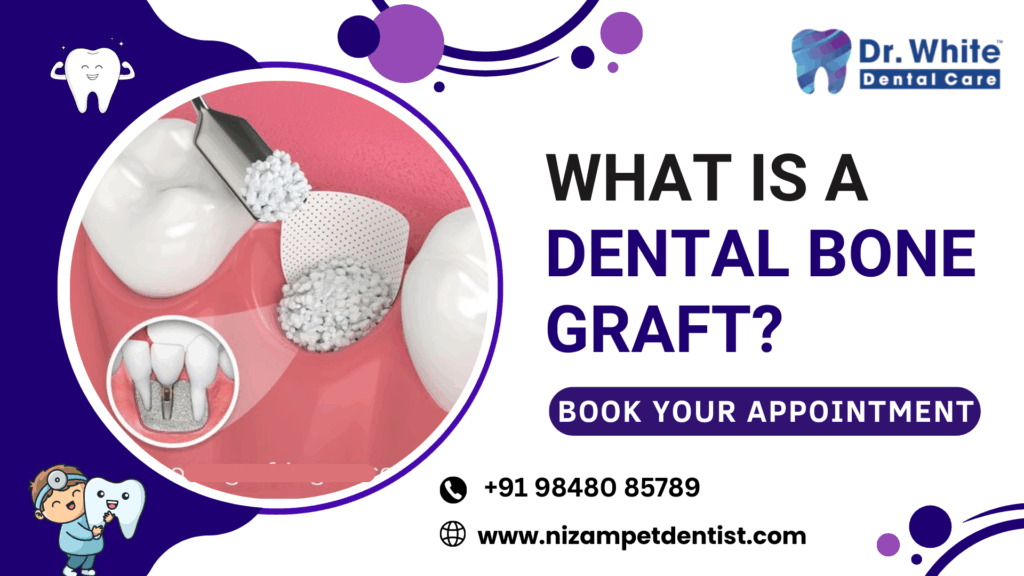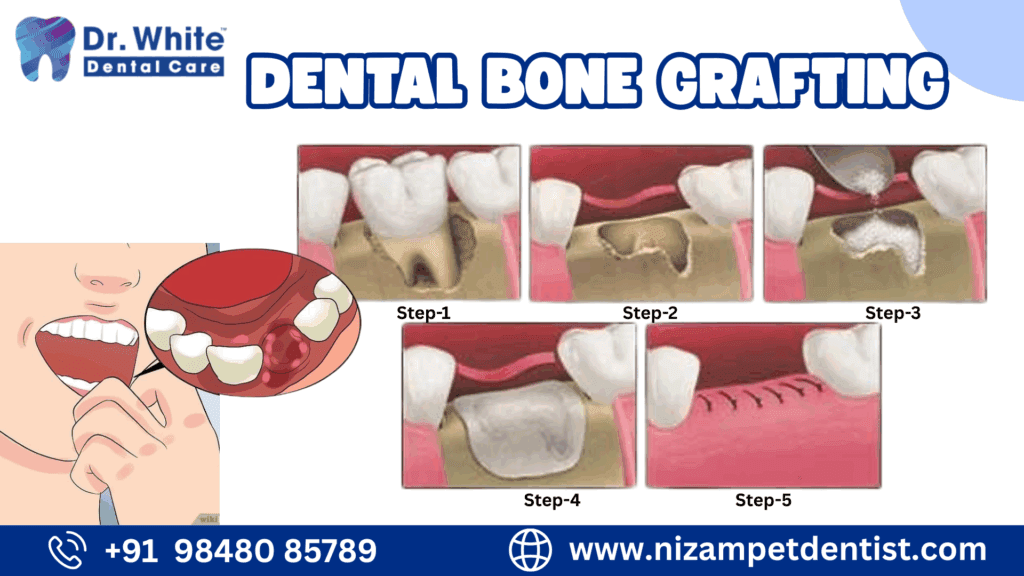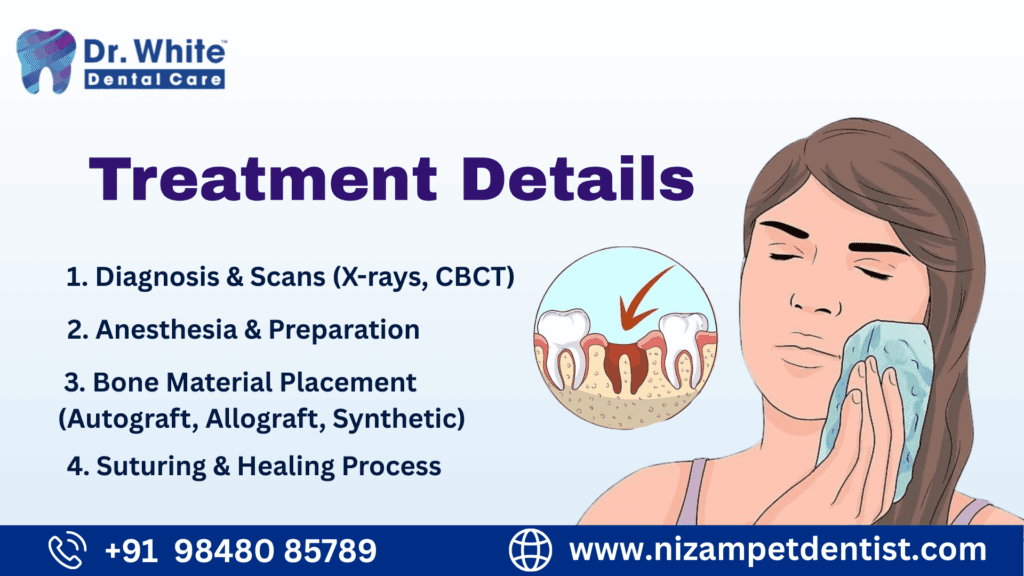What is a Dental Bone Graft?

A dental bone graft is a treatment that helps rebuild or strengthen the jawbone when it becomes weak or too thin to support your teeth. Over time, problems like gum disease, tooth loss, or injury can cause the bone in your mouth to shrink. When this happens, it becomes difficult to replace missing teeth or place dental implants. That’s where a bone graft for teeth is needed. During this procedure, your dentist carefully adds bone material to the weak area of your jaw, which allows new, healthy bone to grow naturally over time. This treatment is very common in dentistry today, especially for patients who are planning to get dental implants in India and worldwide. Many people feel nervous when they first hear about a dental bone graft, often worrying about pain, recovery, or whether it will work. The good news is that the procedure is usually done under local anesthesia, so you don’t feel pain, and most patients heal very well with a high success rate. In this guide, we will explain in detail what a dental bone graft means, why it is needed, how the procedure is done, what risks and benefits to expect, recovery tips, and when to contact your dentist. By the end, you’ll feel more confident about your treatment and understand how a bone graft can restore both your smile and your oral health.
What is a Dental Bone Graft?

A dental bone graft is a common procedure in modern dentistry that helps rebuild and strengthen the jawbone. In simple words, it means adding bone material to areas of your jaw where the natural bone is too weak or too thin. Think of it as repairing or filling weak spots so your jaw can support your teeth properly or hold a dental implant firmly in place. The bone material used may come from your own body, a donor, or artificial substitutes, and over time it fuses with your natural bone to create a solid foundation.
There are several situations where a dental bone graft may be needed:
- Gum disease damage: Severe gum disease can destroy the bone that supports your teeth. A graft helps rebuild this lost bone and protects remaining teeth.
- Missing teeth: If a tooth has been missing for months or years, the bone underneath shrinks. A dental bone graft before implant treatment restores the area so an implant can be placed securely.
- Injury or trauma: Accidents, falls, or sports injuries can damage the jawbone, and grafting helps repair the area.
- Tooth extractions: Dentists sometimes place a graft immediately after removing a tooth to prevent bone loss.
- Preparing for implants: A bone graft ensures the implant has strong support, much like a tree needs firm soil for its roots.
What Conditions Are Managed with a Dental Bone Graft?
- Dental bone grafting is very common today – especially for patients planning to get dental implants.
- Routine step in dentistry – dentists worldwide consider it standard when the jawbone is too weak to hold artificial teeth.
- 50–60% of implant patients need a bone graft – studies show that more than half of people who choose implants require this procedure first.
- Millions of bone grafts are performed globally every year – and the numbers keep increasing as implants become more popular than removable dentures.
- High demand in India – due to better awareness about oral health and access to modern dental technologies.
- Very high success rate – most bone grafts heal successfully and provide strong support for implants.
- Boosts patient confidence – knowing the procedure is safe and effective encourages more people to go ahead with treatment.
- First step to a healthy smile – bone grafting has become an essential part of implant dentistry, ensuring long-term stability and natural results.
How Common Are Dental Bone Grafts?
A dental bone graft is not just for one single problem — it can help in many dental conditions where the jawbone becomes weak or thin. Simply put, it is used when your natural bone is not strong enough to support your teeth or dental implants. Understanding when bone grafting is needed can help patients make the right decision for their oral health.
- Severe tooth loss: When teeth are missing for a long time, the jawbone starts shrinking. A bone graft restores the lost bone so that new teeth, especially bone graft for dental implants, can be placed securely.
- Periodontal disease (gum disease): Advanced gum disease damages the bone that holds teeth in place. Grafting helps rebuild this bone and saves the remaining teeth.
- Jawbone thinning: Sometimes due to age, infection, or natural bone loss, the jawbone becomes too thin. A graft strengthens it so it can support chewing and dental work.
- Preparation for implants: Before placing dental implants, many patients need a graft to create a strong foundation. Without it, implants may not last long.
- Trauma or injury: Accidents, falls, or sports injuries can cause bone loss in the jaw. A graft helps repair the area and restores normal function.
Treatment Details

What Happens During a Dental Bone Grafting Procedure?
If your dentist has recommended a dental bone graft surgery, it’s natural to feel nervous. But knowing the bone graft procedure step by step can help you feel more comfortable and prepared. Here’s what usually happens:
1. Diagnosis & Scans (X-rays, CBCT):
- First, your dentist will carefully examine your teeth and gums.
- Special imaging like X-rays or CBCT (3D scans) is done to measure bone thickness and identify areas that need grafting.
- This step helps your dentist design a personalized treatment plan.
2. Anesthesia & Preparation:
- Before the surgery begins, local anesthesia is given to numb the area.
- This ensures that you don’t feel pain during the procedure.
- For anxious patients, sedation options may also be available.
3. Bone Material Placement (Autograft, Allograft, Synthetic):
- Once the gum is gently opened, bone graft material is placed in the required spot.
- The material can come from:
- Autograft: Your own bone (often from the jaw or hip).
- Allograft: Donor bone from a bone bank.
- Synthetic grafts: Artificial materials that mimic natural bone.
- Autograft: Your own bone (often from the jaw or hip).
- The dentist carefully places the graft to rebuild lost bone and create a stable foundation for future implants.
4. Suturing & Healing Process:
- After the graft is positioned, the gums are stitched back to cover the area.
- Healing starts immediately, as your body begins to grow new bone around the graft.
- Over the next few months, the graft fuses with your natural bone, making it stronger and healthier.
How Painful is a Dental Bone Graft?
One of the most common questions patients ask is: “Is a dental bone graft painful?” The good news is that the procedure itself is not painful because of anesthesia, and most patients report only mild discomfort afterward.
Local Anesthesia Makes It Pain-Free:
- During the surgery, local anesthesia completely numbs the area.
- You won’t feel pain, though you may sense pressure or movement while the dentist works.
- Many patients compare it to having a filling done, but with slightly more preparation.
Mild Soreness After Surgery (Normal):
- Once the anesthesia wears off, it’s normal to feel mild soreness or swelling.
- This discomfort usually peaks within the first 2–3 days and then improves quickly.
- Most patients can return to normal activities within a day or two.
Pain Management Options:
- Your dentist may prescribe pain relievers or recommend over-the-counter medicines like ibuprofen.
- Applying a cold compress on the cheek helps reduce swelling and discomfort.
- Following home-care instructions, like eating soft foods and keeping the area clean, ensures faster healing.
Risks & Benefits
What Are the Potential Benefits of a Dental Bone Graft?
A dental bone graft plays a very important role in modern dentistry. If you’ve lost bone due to missing teeth, gum disease, or trauma, grafting can restore strength and give long-term benefits. Here’s why patients choose it:
Better Support for Implants:
- The main advantage of dental bone grafting is that it provides a strong foundation for dental implants.
- Implants need solid bone to stay fixed, and a graft ensures the bone is strong enough to hold them securely for years.
Mild Soreness After Surgery (Normal):
- When bone is lost, the jaw may look thinner or uneven.
- A graft rebuilds lost bone and helps maintain the natural shape of your jaw.
Improves Oral Function and Aesthetics:
- Bone grafting allows you to chew food properly and smile confidently.
- It improves speech clarity, bite strength, and the overall look of your teeth and jaw.
Prevents Facial Sagging:
- Missing teeth and bone loss can cause the face to sag or look older.
- By restoring bone, grafting supports your facial structure and helps you maintain a youthful appearance.
Who Is a Good Candidate for Dentures?
Many patients ask about the dental bone graft success rate. The good news is that bone grafting is highly reliable when done by skilled dentists and followed with proper care.
Success Rate: 90–95%
- Studies show that most dental bone grafts heal successfully.
- Around 9 out of 10 patients have excellent results, making it a trusted procedure worldwide.
Depends on Patient Health, Hygiene, and Aftercare:
- Non-smokers and patients who follow oral hygiene habits tend to heal faster.
- Carefully following your dentist’s aftercare instructions increases success.
- Managing health issues like diabetes or gum infections is important for better healing.
Role of Skilled Implantologists:
- The dentist’s experience plays a big role in long-term success.
- A skilled implantologist ensures the right graft material, placement, and post-surgery guidance.
What Are the Risks or Complications of Dental Bone Grafts?
Like any medical procedure, dental bone grafting has some risks. The good news is that complications are rare and usually minor when treated on time.
Swelling, Infection, or Bleeding:
- Mild swelling and slight bleeding are normal for a few days after surgery.
- Your dentist may prescribe antibiotics to prevent infection.
Rare Cases: Graft Rejection:
- Very rarely, the body may not accept the graft material.
- In such cases, your dentist can replace it with another grafting option.
Preventing Risks with Good Care:
- Follow aftercare instructions like eating soft foods, avoiding smoking, and keeping the area clean.
- Attend follow-up visits so your dentist can check healing progress.
Recovery and Outlook
How Long Does It Take to Recover from a Dental Bone Graft?
The healing process after a dental bone graft happens in two stages:
Initial Healing
- In the first few days, you may notice mild swelling, soreness, or slight bleeding.
- These symptoms usually settle within 7–10 days.
- Stitches may dissolve on their own, or your dentist will remove them after about a week.
Full Bone Integration (3–6 months):
- The real recovery is when the grafted bone fuses with your natural jawbone.
- This process, called osseointegration, takes between 3 to 6 months depending on your health, graft size, and oral hygiene.
- Only after this healing phase is complete can your dentist place a dental implant securely.
What Are the Side Effects of a Dental Bone Graft?
It’s normal to experience a few side effects after surgery. Most are temporary and go away with proper care:
Rare Cases: Graft Rejection:
- A little discomfort is expected after surgery.
- Painkillers and cold compresses usually help manage this easily.
Temporary Numbness:
- You may feel slight numbness around the treated area due to anesthesia.
- This usually fades within a few hours to a couple of days.
Minor Bleeding (1–2 days):
- Light bleeding or oozing from the area may happen for the first 24–48 hours.
- Dentists advise biting on gauze to stop it.
Is There Anything I Can Do to Make This Treatment Easier on Me?
Yes! Your recovery depends on how well you care for yourself at home. Following your dentist’s instructions is the key to smooth healing. Here are simple tips:
Use Ice Packs:
Applying ice packs to the outside of your cheek reduces swelling and pain in the first 48 hours.
Eat Soft Foods:
- Stick to soups, smoothies, mashed foods, and yogurt.
- Avoid hard or crunchy foods that may disturb the graft.
Maintain Good Oral Hygiene:
- Brush gently around the graft area.
- Use any prescribed mouthwash to keep the area clean.
Avoid Smoking & Alcohol:
- Smoking slows down blood flow and delays healing.
- Alcohol can irritate the surgical site.
Rest Well:
- Give your body time to heal by getting enough sleep and avoiding strenuous exercise for a few days.
How Long Does a Dental Bone Graft Last?
Patients often ask: Does a dental bone graft last forever? The good news is that with the right care, it can last for decades—sometimes even a lifetime.
Long-lasting if Cared for Properly:
- Once the graft fuses with your natural bone, it becomes a permanent part of your jaw.
- Good oral hygiene is essential to keep it strong.
Can Last a Lifetime with Proper Hygiene and Follow-ups:
- Brushing twice daily, flossing, and routine dental checkups will help maintain the graft for life.
- Regular professional cleanings also protect against gum disease, which can weaken bone.
When to Call the Doctor
While most dental bone graft procedures heal smoothly, it’s important to know the difference between normal recovery signs and symptoms that may indicate a complication. Calling your dentist at the right time can prevent small issues from becoming serious.
Severe Pain Not Managed by Medicine
Mild soreness is normal, but if the pain becomes sharp, throbbing, or unmanageable even after taking prescribed painkillers, it’s a warning sign.
Excessive Bleeding
- Slight bleeding or oozing for the first day or two is expected.
- If bleeding continues heavily, or if you need to change gauze pads very often, contact your dentist immediately.
Pus or Signs of Infection
- Swelling is normal for a few days, but if you notice pus, a foul taste, or persistent swelling that worsens, it could be an infection at the graft site.
Fever After Procedure
- A low-grade fever for a short time may occur.
- However, a persistent or high fever signals the body is fighting an infection and requires professional care.
Conclusion
A dental bone graft is a safe and effective procedure that rebuilds jawbone loss and provides strong support for dental implants, helping restore both oral health and facial appearance. Today, it is a common treatment with a success rate of over 90–95%, making it a trusted solution for patients with missing teeth, gum disease, or jawbone thinning. While mild swelling or discomfort may occur, most patients recover smoothly and enjoy long-lasting results. With proper care, a bone graft can last a lifetime, giving you the confidence to smile, eat, and speak without worry. At Nizampet Dentist, we provide advanced, affordable dental bone grafting and implant treatments, making us one of the best dental bone graft clinics in Hyderabad. If you are planning implants or want to strengthen your oral health, book an appointment with our expert team today for safe, personalized care.
We are here
Enquire Now
Error: Contact form not found.
FAQ
- The procedure is done under local anesthesia, so you won’t feel pain during surgery.
- Mild soreness or swelling after the procedure is normal.
- Pain can be managed with prescribed medicines and home care.
- Bridges are fixed in place, while dentures are removable.
- Dentures are better if you’re missing many teeth or want a budget option.
- Bridges feel more natural and are easier to get used to for smaller gaps.
- Mild risks like swelling, bleeding, or temporary numbness.
- Rare chances of infection or graft rejection.
- Requires several months of healing before implants can be placed.
- Often recommended if bone loss is expected after removal.
- Helps preserve jaw structure for future implants.
- Prevents shrinking of gums and facial sagging.
- Basic grafting in India: ₹10,000 – ₹25,000 (approx.).
- Advanced grafts for implants: ₹30,000 – ₹60,000 or more.
- Costs vary by material, clinic, and complexity.
- No strict age limit if overall health is good.
- Usually done for adults above 18 once jaw growth is complete.
- Older patients can also get grafts if medically fit.
- Short dental implants that need less bone.
- Zygomatic implants (anchored in cheekbone).
- Ridge expansion or sinus lift techniques.
- Graft may not integrate with natural bone.
- Signs include pain, swelling, or implant mobility.
- Dentist may repeat the graft or suggest alternative solutions.
- Eat soft foods and avoid hard chewing on the area.
- Use ice packs and take prescribed medicines.
- Maintain gentle oral hygiene and avoid smoking or alcohol.
- Yes, but usually after initial healing (2–3 weeks).
- Dentures may need adjustments to avoid pressure on the graft.
- Dentist will guide when it’s safe to use them comfortably.
